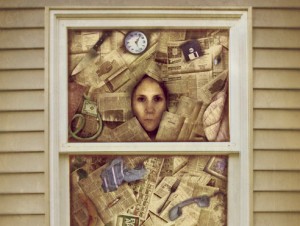Compulsive Hoarding

“At the end, all that’s left of you are your possessions. Perhaps that’s why I’ve never been able to throw anything away. Perhaps that’s why I hoarded the world: with the hope that when I died, the sum total of my things would suggest a life larger than the one I lived.”
― Nicole Krauss
There are people who like to collect things such as stamps, dolls, antiques, etc. Hoarders on the other hand demonstrate a pattern of behavior that is characterized by the excessive acquisition of an inability or unwillingness to discard large quantities of objects that would seemingly qualify as useless or without value. The presentation and level of mental illness with hoarders varies and is diverse. Compulsive Hoarding is similar to OCD (Obsessive Compulsive Disorder) and is considered an OCD spectrum disorder but not all hoarders have the OCD diagnosis. Similarly, not all individuals diagnosed with OCD become hoarders. Current research estimates about 1-2% of individuals diagnosed with OCD have problems with hoarding and only 2-5% of the population is struggling with hoarding. Currently compulsive hoarding is not yet recognized as a diagnosable disorder in the DSM-IV (Diagnostic and Statistical Manual of Mental Disorders).
Features of Compulsive Hoarding
Individuals suffering from compulsive hoarding typically have poor insight, suffer from cognitive distortions, are distractible, and have trouble making decisions. They tend to be perfectionistic and afraid to make mistakes. They have difficulty categorizing items and difficulty with organization and memory. Due to the poor memory , hoarder typically like to have everything out in front of them but they end up having so many things out, they become overwhelmed and items do not trigger their memory. This is different from being cluttered or simply messy. They tend to over-sentimentalize items and become attached to material objects. Discarding items becomes very difficult. These individuals typically acquire items which usually have no value to most people. As a result, they cannot access their home as it’s meant to be. This will cause marked distress to the individual and causes relational issues and impairs life functioning. For many individuals, sorting items become so anxiety provoking, they end up avoiding the task, resulting in even more anxiety. They justify buying items either out of guilt or to please others (e.g. be a good mom, wife, friend, etc.). These individuals end up becoming more and more isolated as the hoarding progresses. They become afraid of having others over to their homes or family members, out of embarrassment, avoid socializing with others.
Other features of Hoarding:
- Hoarders tend to hold onto a large number of items that most people would consider not useful or valuable (e.g. junk mail, old catalogs and newspapers, clothes that “might” be worn one day, trash, and freebies picked up).
- The home is so cluttered that it is inaccessible and can no longer be used for intended purpose (e.g. beds that cannot be slept in, the refrigerator filled with rotten food, stove top covered with junk mail or old food, dining table and chairs covered with items, filthy bathrooms, or dead animals).
- The clutter and mess is so bad it causes illness, distress, and impairment (e.g. individual is isolated from others, family at risk for fire, falling, infestation, or eviction, personal relationships are impaired, and the individual feels depressed or anxious most of the time because of the clutter)
Causes of Hoarding
Many individuals who hoard have a genetic predisposition towards hoarding. A genetic abnormality has been identified and some people are “wired” to hoard but it’s the erroneous beliefs and cognitive distortions that maintain the behavior. For some individuals, a traumatic or stressful event can exacerbate the problem such as the loss of a spouse, divorce, or going through empty nest.
Challenges
Due to the lack of insight and motivation associated with hoarding, it is very difficult to get individuals into treatment and to stay in treatment. Hoarders were significantly less likely to see a problem in a hoarding situation than a friend or a relative might. Educational presentations are helpful in raising awareness and reducing the stigma of seeking treatment.
Treatment Options
For most individuals, family members are the first to notice hoarding patterns. The typical referral age for an individual suffering from hoarding is between 40-50 due to the length of time required for pattern recognition and to accumulate items but the age of onset can be as early as age 13. Family members usually are the ones that initiate and encourage treatment but the individual must want help and accept interventions. Usually family members become alarmed and feel powerless, having nowhere to turn. Family members can collaboratively work with the therapist once they agree to some ground rules such as:
1.) Family members are encouraged to NOT clean the house or throw away the hoarding individuals belongings. Doing so is not helpful because it will cause the hoarder extreme anxiety, leading to more hoarding.
2.) Allow the hoarding individual to identify goals for themselves and allow them to work at their own pace. Family members cannot dictate this.
3.) Never touch the hoarding individuals possessions unless they have permission to do so.
4.) All decisions about items must be made by the hoarder, whether family members agree or not.
The individual working with a mental health professional will typically start with a family meeting.. The family as well as the individual will be educated about the disorder in order to increase insight and awareness. Undergoing a comprehensive behavioral assessment is key. The therapist might physically go to the house and walk through the house to assess the living situation or rely on pictures provided by family members. Infestations of insects and rodents, along with safety hazards like blocked doorway and windows will be identified. Many hoarders have so much stuff, walking through the home can be difficult. A comprehensive clinical interview with family members and the individual will determine the functional aspect of the hoarding (antecedents, behaviors, consequences) and reinforcements will be identified. Alternative replacement behaviors will be identified. The mental health practitioner will also need to assess the health of the individual’s relationships with others. Are they isolated, have legal and financial issues, difficulty keeping a job?
Once a treatment plan has been established, the individual hoarder decides where in the home they want to start. Typically they will start in a section that causes the least amount of anxiety. There will be many opportunities to address cognitive distortions and anxiety during this process (For individuals who live too far or do not want the therapist to come to their homes, they can bring bags of items to the therapist office). A structured sorting system focused on categorizing the items is crucial. The categorization system must be established in advance and adhered to in order to avoid justifications for keeping items or getting distracted by items. There should be a Keep, Donate, and Discard pile and the therapist can work with the client during the sorting process. The process might be very overwhelming and they may have difficulty coping with the process. These issues can be addressed by the therapist as the process continues. It’s important for the therapist to slow down the pace and take a break if the process becomes too overwhelming for the client. The goal is to teach the client skills they can maintain over time. It’s also extremely important for the client to only handle an item one time and make a decision prior to moving on to the next item. Moving items from pile to pile is a typical behavior pattern for the hoarder and is not helpful. It’s also important to keep the client on task and limit distractions such as stories about the item or justifications for keeping items. Addressing the shopping experience with the hoarder is very important as well. For most hoarders, the value of an object increases significantly once they hold the object in their hands. Helping them overcome this process is key to reducing the need to buy and perpetuating the hoarding cycle. Please contact a mental health professional in your community if you or someone else is dealing with hoarding.
Video : OCD Hoarding Youtube
 Dr. Nafisa Sekandari is the director and founder of Mental Health 4 Muslims.com. Dr. Sekandari is currently licensed and practicing in California and Arizona. Dr. Sekandari is also the current founder and director of MH4M Counseling and Education Center in Phoenix, Arizona. Additionally, Dr. Sekandari is a published author and lecturer.
Dr. Nafisa Sekandari is the director and founder of Mental Health 4 Muslims.com. Dr. Sekandari is currently licensed and practicing in California and Arizona. Dr. Sekandari is also the current founder and director of MH4M Counseling and Education Center in Phoenix, Arizona. Additionally, Dr. Sekandari is a published author and lecturer.

